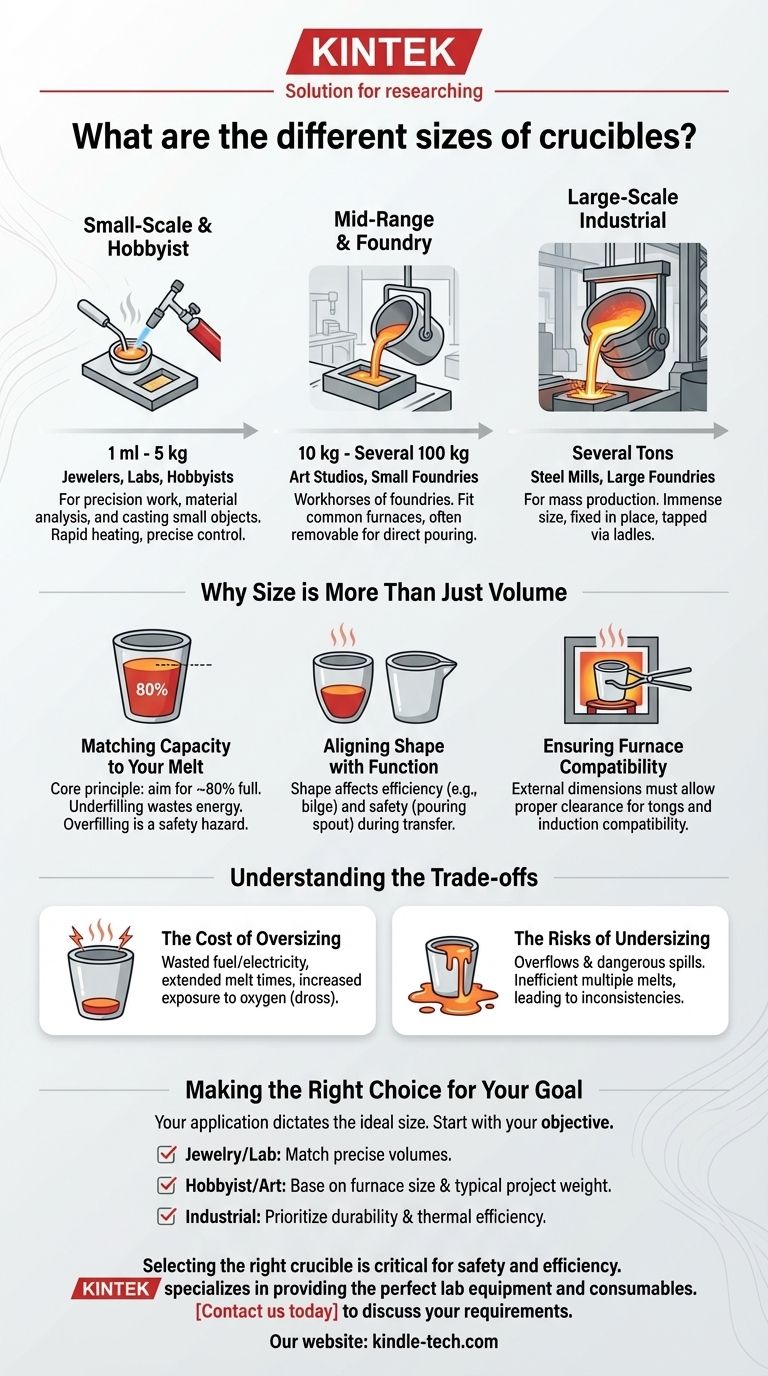Crucible sizes range dramatically, from vessels as small as a teacup for jewelers to massive industrial crucibles capable of holding several tons of molten metal. The size of a crucible is defined not by arbitrary labels like "small" or "large," but by its specific capacity, which is directly tied to the scale and nature of the melting operation it's designed for.
The critical insight is that choosing a crucible is not about its absolute size, but about matching its capacity, shape, and material to the specific volume of metal you need to melt and the type of furnace you are using.

The Spectrum of Crucible Sizes
Crucibles are manufactured to serve distinct purposes, from delicate precision work to heavy industrial production. Their size directly corresponds to these applications.
Small-Scale & Hobbyist Crucibles
These are the smallest crucibles, often measured in milliliters or single-digit kilograms (e.g., 1-5 kg). They are typically used by jewelers, in laboratory settings for material analysis, or by hobbyists for casting small objects. Their compact size allows for rapid heating and precise control over small quantities of precious or specialized metals.
Mid-Range & Foundry Crucibles
This category covers a broad range of sizes, often from 10 kg up to several hundred kilograms. These are the workhorses of small foundries, art studios, and serious casting operations. They are designed to fit into common fuel-fired, electric resistance, or induction furnaces and are often removable to allow for direct pouring of the molten metal into molds.
Large-Scale Industrial Crucibles
At the highest end are industrial crucibles, whose capacity is measured in tons. These are used in large-scale foundries and steel mills for mass production. Due to their immense size and weight when full, they are almost always fixed in place within a large furnace, and the metal is tapped or transferred via ladles.
Why Size is More Than Just Volume
Selecting the right crucible involves more than just finding one that can hold your material. The dimensions and shape are intrinsically linked to efficiency, safety, and compatibility with your equipment.
Matching Capacity to Your Melt
A core principle is to use a crucible that will be about 80% full when the metal is molten. Underfilling a large crucible wastes significant energy and time heating the empty space. Overfilling is a serious safety hazard, creating a high risk of spillage when moving the crucible or as the metal expands.
Aligning Shape with Function
Crucibles come in a variety of shapes (e.g., bilge, straight-walled "A" shape) for specific reasons. A bilge shape, which is wider in the middle, can improve heating efficiency in certain furnaces. The presence and design of a pouring spout are also critical for safely and accurately transferring molten metal.
Ensuring Furnace Compatibility
The external dimensions of the crucible must allow for proper clearance within your furnace. There needs to be enough space for tongs to securely grip the crucible for removal. In induction furnaces, the crucible's size and material composition must be compatible with the furnace's electromagnetic field to ensure effective heating.
Understanding the Trade-offs
Choosing the wrong size is not just an inconvenience; it has direct consequences for your process, safety, and budget.
The Cost of Oversizing
Using a crucible that is too large for your typical melt size leads to wasted fuel or electricity. It extends melt times and can increase the metal's exposure to oxygen, potentially creating more dross or impurities.
The Risks of Undersizing
Attempting to melt more metal than a crucible is rated for can lead to overflows and dangerous spills. It also forces you into inefficient multiple melts for a single project, which can introduce temperature inconsistencies and casting defects.
Making the Right Choice for Your Goal
Your application dictates the ideal crucible size. Use your primary objective as the starting point for your selection.
- If your primary focus is jewelry or lab work: Choose a small crucible with a capacity that precisely matches the small, controlled volumes you work with.
- If your primary focus is hobbyist or art casting: Select a crucible based on the size of your furnace and the weight of your most common casting projects, ensuring it's never more than 80% full.
- If your primary focus is industrial production: Your choice will be determined by the furnace's design and the required throughput, prioritizing durability and thermal efficiency.
Ultimately, the right crucible is the one that safely and efficiently meets the demands of your specific task.
Summary Table:
| Application | Typical Capacity Range | Common Users |
|---|---|---|
| Small-Scale & Hobbyist | 1 ml - 5 kg | Jewelers, Labs, Hobbyists |
| Mid-Range & Foundry | 10 kg - Several 100 kg | Art Studios, Small Foundries |
| Large-Scale Industrial | Several Tons | Steel Mills, Large Foundries |
Selecting the right crucible is critical for safety and efficiency. KINTEK specializes in providing the perfect lab equipment and consumables for your specific melting needs. Whether you're in jewelry making, research, or industrial production, our experts can help you find a crucible that ensures optimal performance and safety. Contact us today to discuss your requirements and enhance your melting process with KINTEK's reliable solutions!
Visual Guide

Related Products
- High Purity Pure Graphite Crucible for Electron Beam Evaporation
- High Purity Pure Graphite Crucible for Evaporation
- Arc-Shaped Alumina Ceramic Crucible High Temperature Resistant for Engineering Advanced Fine Ceramics
- Engineering Advanced Fine Ceramics Alumina Al2O3 Crucible With Lid Cylindrical Laboratory Crucible
- Engineering Advanced Fine Ceramics Alumina Crucibles (Al2O3) for Thermal Analysis TGA DTA
People Also Ask
- What are the effects of magnetron sputtering? Achieve High-Quality, Durable Thin Films for Your Lab
- What is sputtering in plasma treatment? A Guide to High-Purity Thin Film Deposition
- What is a magnetron sputtering? A Guide to High-Quality Thin-Film Deposition
- What is the difference between VAR and ESR? A Guide to Understanding Tail Risk in Financial Modeling
- How does a magnetron sputtering work? A Guide to High-Quality Thin Film Deposition



















